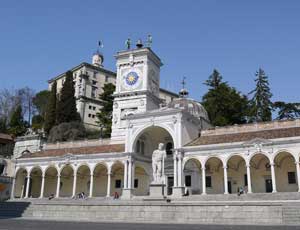Udine (pronounced Oodinay) is a provincial capital in the north-eastern Italian region of Friuli-Venezia Giulia. With a population of 100,000, it is one of the most important towns in this corner of Italy, although it is not much known to tourists.
Udine has a long and interesting history, and like much of Italy’s far north-east it isn’t wholly Italian. Close to the borders with Austria and Slovenia, and between the Alps and the Adriatic Sea, Udine is a town with many flavours. It has been Venetian, and Austrian, and as well as Italian you will also find signs written in Slovenian and a local language, Friulano. Udine has a well-ordered feel that is un-Italian. Two small medieval canals flow through the town centre, sometimes hidden underground and other times making attractive additions to the townscape. You can still see steps and sloping stones by the water which were designed as places for clothes-washing.
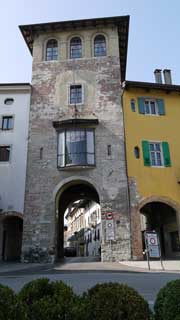
Although it has been damaged several times by earthquakes and wars, Udine still retains an atmospheric historic centre, a grand piazza for admiring and another, ancient but less grand, for relaxing, and a lot of charm. The more modern streets surrounding the historic nucleus are well-laid-out, and dotted with trees and pretty, well-maintained little parks.
This attractive university town makes a good base for exploring Friuli, or for spending a day or two during a tour of north-eastern Italy. Food and drink is good, plentiful, and affordable, there are cultural and architectural sights, and the town has a pleasant, enjoyable atmosphere.
Udine tourist sights
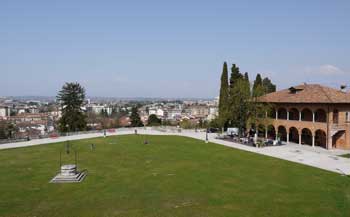
If you are interested in seeing several of the town’s attractions, it’s worth considering a combined ticket. At the time of writing there is a useful tourist ticket called the Friuli-Venezia Giulia (FVG) Card which includes admission to scores of museums in the region as well as other perks. This can be bought for different time periods. Udine urban bus travel is free to cardholders, as is travel on the Udine-Cividale del Friuli railway line. All the principal museums in Udine are included in the scheme, and you also get a free audioguide as part of the deal, so it is well worth buying. You can buy the card at selected Udine hotels, and at the tourist information office. There are also combined tickets for Udine’s museums.
Located in Piazza 1 Maggio, under the castle hill, Udine’s tourist information office is a good place to begin your tour of the town, picking up maps, information, audioguides or even free bike hire. You can collect a list of opening times, which is essential as the town’s attractions have varying opening hours, and some close for a long lunch break. The office also has information on the other towns and tourist sights in the region. It is located around ten-fifteen minutes’ walk from the railway station (see below for directions).
From Piazza 1 Maggio, visitors can head through an old town gateway and along Via Manin to the heart of town. Alternatively, a zig-zag route up the castle hill will bring you, via the back door, to Udine’s most dramatic and panoramic spot. After climbing the slope, you emerge by Udine’s ‘castle’, the Castello. Crowning this steep and solitary hill, the actual building is an anti-climax, but the setting isn’t. Rather than a fortified castle, the Castello is a large sixteenth century palazzo which now holds several of the town’s museums. The gateway alongside gives access to a large panoramic area, with far-reaching views from the Alps to (on a clear day) the Adriatic Sea. The popular story is that Attila the Hun ordered his men to build this hill, carrying earth in their Hunnish helmets, so that he could stand on the summit and watch the burning of Roman Aquileia. The obvious potential of this hill as both a viewpoint and a defensive base explains at once the location of Udine and its longlasting significance. Nowadays, with benches and a grassy lawn, the castle grounds are simply a nice spot for relaxation and admiring the views.
Housed in the Castello, Udine’s Musei Civici (town museums) are an important stop on a sightseeing tour. The principal museum is the Galleria d’Arte Antica, a good art gallery. Situated on the building’s piano nobile, the collection includes some fine paintings, such as Carpaccio’s Christ, with a pretty floral foreground and animals in the background. This painting, and others in the same room, are reminders that once upon a time angels had brightly multi-coloured wings. Look out for some lovingly-depicted dogs in the next room, and a rather doubtfully-attributed Caravaggio further on in the itinerary. Some strong artistic contenders from this part of Italy are featured, including Antonio Carneo, represented by fine works such as the portrait of an old wanderer, Il Giramondo. After passing through the grand Parliament Hall, the gallery finishes with an interesting mixed collection of nineteenth-century work, including some nice portraits and family groups, and a painting of the the Flood by Filippo Giuseppini that is rather reminiscent of Saddam Hussein’s taste in artworks. I liked the portraits by local artist Oderico Politi, and his portrayal of Socrates and his circle as recognisably nineteenth-century gentlemen.
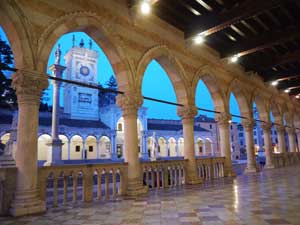
Upstairs from the art gallery is a museum of historic prints and a photography museum, all included in the entrance fee. There is also an archaeological museum in the building, though this was closed at the time of my visit. I’d recommend a quick tour of these, if you have time. The photography collection, in particular, paints a vivid picture of life in Udine and the nearby mountains over a century ago, and includes fascinating photographs of both rural and urban scenes: a dirigible over Udine; the aftermath of an earthquake in 1928; young female porters carrying heavy loads on their backs, with the surly secretive challenge in their eyes that you see in their modern day teenage counterparts as they loaf on station platforms, sending text messages and listening to MP3 players.
Next to the castle is the church of Santa Maria del Castello (St. Mary of the Castle), remodelled several times since a devastating earthquake in 1511, but still containing some fourteenth-century frescoes. On top of the belltower is a large bronze angel weather vane.After visiting the castle, the route down to the heart of Udine descends through an elegant arcade and beneath a large stone gateway, the Arco Bollani, which was designed by Andrea Palladio.
Udine was ruled by Venice for many centuries, and the Venetian influence is particularly evident in the theatrical square below the castle, Piazza della Libertà. Here is Udine’s town hall, the Palazzo del Comune, a pink and white version of Venice’s Doge’s Palace. Also called the Loggia del Lionello, Udine’s version dates to the fifteenth century, though it was partially rebuilt after a fire in 1876, and it is a lovely example of the Venetian Gothic style. Opposite the Loggia del Lionello is another arcade, the Loggia di San Giovanni, centred around a clocktower topped with bronze statues that, again, is a close relative to the one in Venice’s Piazza San Marco. The square is also decorated with a mismatched assortment of statues, including the Venetian Lion of St. Mark.
Udine’s main shopping and promenading streets are in the area around Piazza Libertà and the town’s other principal square, called Piazza Matteotti. This old market square is surrounded by picturesque old buildings, and lined with cafes and bars. It’s a prime spot for meeting up with friends, and sitting and relaxing at an open air table with a cheap glass of local wine while watching Udinese life go by. The square’s artistic highlight is the Renaissance façade of the Chiesa di San Giacomo. Making a loop north of the piazza, you’ll pass along some of Udine’s prettiest streets and palaces, including Palazzo Antonini, designed by Palladio. There are several good places to eat and drink in this area, many of them popular with the local university crowd. As well as attractive architecture, you’ll also pass picturesque stretches of a swift-flowing little roggia, one of Udine’s characteristic waterways.
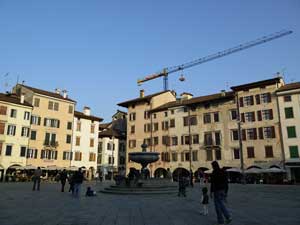
Back on the tourist trail, Udine’s cathedral, the Duomo, is worth a quick visit, although the interior isn’t particularly interesting (do look out, though, for some 3D trompe l’oeil angels). You can see works by Tiepolo here and also in a chapel across the street to the right of the Duomo, the Oratorio della Purità (ask in the Duomo, as the chapel is kept locked). Note the charming ancient stone carvings over the doorway of the Duomo. Don’t miss the Museo del Duomo, situated in the baptistery behind the cathedral (round to the left), where you can admire some charming early frescoes and also a wonderful fourteenth-century sarcophagus supported by exquisitely elegant statues of saints; one of the loveliest things you’ll see in Udine.
One of Udine’s proudest boasts is that it is the ‘City of Tiepolo.’ Venetian artist Giambattista Tiepolo (1696-1770) came to Udine early in his career to carry out important commissions, and has left an extensive legacy in the town. His work can be seen in the Castello, the Duomo and adjacent Oratorio, and it covers the walls of the old Patriarchal Palace, now the Museo Diocesano, or Gallerie del Tiepolo (on Piazza Patriarcato).
If folk-history interests you, pay a visit to the town’s smart new Ethnographic Museum (Museo Etnografico di Friuli). A short walk from the heart of town, on Borgo Grazzano, this is a museum covering the history and traditions of the people of the Friuli area. There’s a video-guide in English, though many of the exhibits lanterns, ceramics, postcards from America don’t need much explanation. Interesting items include naïve family portraits, traditional costumes, amulets and ex-voto paintings illustrating dreadful mishaps and thanks ‘for grace given’. This is a fascinating museum and frequently charming, which, combined with the historic photos in the Castello’s photography museum, really brings to life the human history of the area, and traditional ways of life which continued well into the twentieth century.
If you liked the ex-votos displayed in the Ethnographic museum, you might wish to pay a visit to the Santuario di Santa Maria delle Grazie on Piazza 1 Maggio, where the church’s entrance contains many more tokens of thanks to Jesus and saints. Many are metal badges; the most unusual by far is the ‘Maschera del Diavolo,’ a suit of armour with devil’s horns, worn into the church by an impious reveller who later repented. In the entrance to the cloister to the right of the church there are more quaint painted ex-votos on display, leaving the viewer to reflect on the dangers of horse-drawn travel, and open windows.
Another important Udine museum is GAMUD, a long-established modern art gallery. At the time of writing this is situated just north of the centre of town (walk, or take bus number 2). It also has a more central outpost on Via Savorgnana where as well as local architecture archives and a pleasant courtyard garden, a gallery called Il Progetto hosts exhibitions on architecture and design themes.
Food and drink
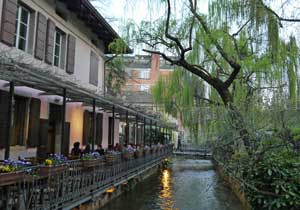
The local traditional aperitivo is called a tajut, and one of the best places to enjoy this is Piazza Matteotti. Around this square, and up the neighbouring Via Sarpi and Via Zanon you’ll find a good choice of hostelries for anything from a glass of local Friulano wine to a full meal. Just between the piazza and Via Zanon, I found the unpretentious Osteria Alla Ghiacciaia to be a nice spot with a charming canalside terrace, cheap house wine and traditional dishes on the menu. For a drink or meal in smart surroundings, try the 1920s elegance of Caffè Contarena, alongside the Loggia del Lionello.
Travel and transport
Udine is on a regional train line from Venice, less than two hours away. Tickets are very cheap although the commuter trains aren’t particularly fast or comfortable. There are also trains to Trieste and Gorizia. Udine’s railway station and bus station are close together to the south of the town centre, about a ten-fifteen minute walk away. To reach the centre, cross the road outside the station and walk straight up Via Roma, continuing straight along Via Dante which then becomes Via Savorgnana. Udine’s city buses are run by SAF, although since the centre is visitable on foot, tourists may not bother with these.
The nearest airport is Friuli-Venezia Giulia (Trieste) Airport, 25 miles away. There’s a direct bus from the airport, number 51, operated by APT Gorizia.
Some of the surrounding area, including Grado and Aquileia, can be visited by public transport, using SAF buses or the private little Udine-Cividale railway line, which runs to the picturesque Lombard town of Cividale del Friuli, a great day out from Udine.
Hotels
I stayed right opposite the station in the convenient and friendly three-star Hotel Principe. For a smarter option near the historic centre, try the Astoria Hotel Italia. Between the two is the Ambassador Palace, a popular four-star hotel a few minutes’ walk from the station, on the route into the heart of town.
> Choose a hotel, B&B or apartment in Udine
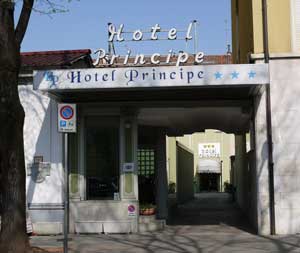
On this site
Useful external links
